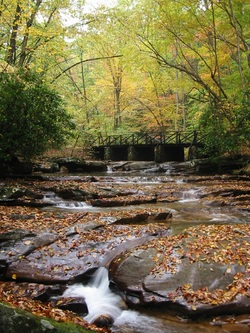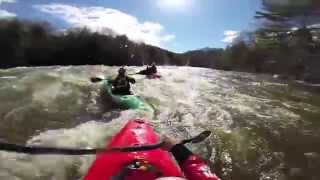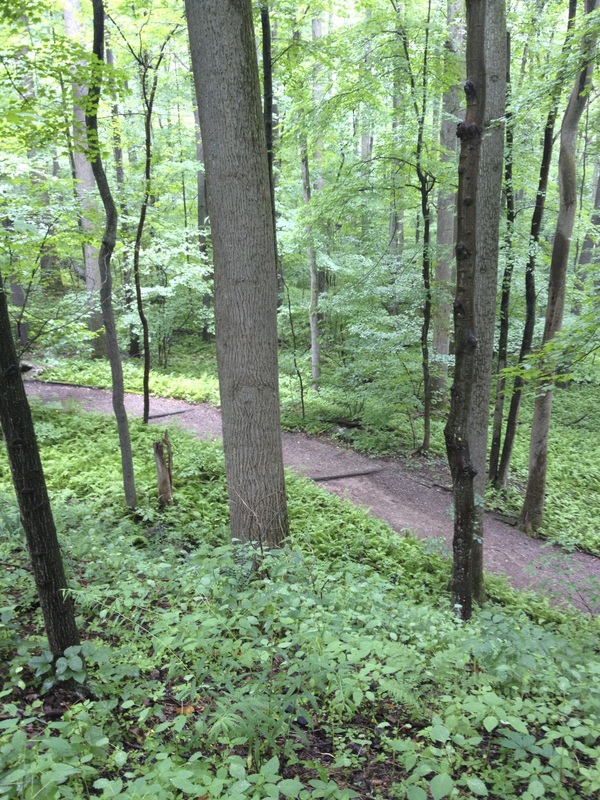WHITE WATER RIVERS
|
The river is high and moving fast ~ riding the rapids are going to be a blast!
Are you looking for white water adventure to explore?
Check out our outfitters, equipment, photos, reviews and more. Start your next outdoor adventure. Read our blog for real whitewater stories and reviews. |
Featured area: Ohiopyle
|
River:
Youghiogheny |
Location:
USA |
State:
Pennsylvania |
Area:
Fayette County |
Neighborhood:
Ohiopyle |
Youghiogheny River
Advanced and technical, whitewater rafting the Upper Yough is heart pounding fun. Dropping almost 1000 feet in the 10 miles from Sang Run to Friendsville, non-stop action. The first few miles of the Upper are easier, giving paddlers a chance to warm up some; then the river gets steeper and the rapids are fast and more difficult. The last few miles are easier as you near the take-out at Friendsville.
The Youghiogheny scenic and wild River is part of the large Mississippi River watershed that stretches from the western slope of the Appalachian Mountains in the east to the Rockies in the west.
Beginning in the gently rolling farmlands of southern Garrett County, the Youghiogheny cuts a northward path through some of the most rugged mountain scenery in Maryland before running into Pennsylvania and merging with the Monongahela at McKeesport, Pennsylvania.
Beginning in the gently rolling farmlands of southern Garrett County, the Youghiogheny cuts a northward path through some of the most rugged mountain scenery in Maryland before running into Pennsylvania and merging with the Monongahela at McKeesport, Pennsylvania.
Events:
Upper Youghiogheny River Rafting: Class V+ = Advanced
Middle Youghiogheny River Rafting: Class I-II = Beginner
Lower Youghiogheny River Rafting: Class III-IV = Intermediate
Confluence to Ohiopyle. Slow to medium pace ride through the scenic Laurel Highlands. Kick back and enjoy the scenery
The Lower Youghiogheny is probably the most popular section of the river. There are lots of rapids with names like Entrance, Cucumber, Railroad, Dimple, Swimmers and Double Hydraulics. These rapids are perfect for a broad range of experience levels.
The most dangerous spot on the Lower Yough, Dimple Rock was the site of three deaths in 2000. All were rafters or kayakers in inflatables.
Rafting Outfitters
- Rafting Companies Upper Yough Expeditions: 800-248-1893
- Precision Rafting: 800-477-3723
- Ohiopyle Trading Post: 888-644-6795
- Wilderness Voyageurs: 800-272-4141
- White Water Adventures: 800- 992-7238
- Laurel Highlands River Tours: 800-472-3846
Parks:
STAY
Local websites:
An awesome website dedicated to Ohiopyle PA. Find places to stay, things to do, photos and much more! Like us on facebook!
Located at the southern reaches of the Laurel Ridge, Ohiopyle State Park encompasses approximately 20,500 acres of rugged natural beauty and serves as the southern gateway to the Laurel Highlands.
Ohiopyle walking trail
Ohiopyle PA is a great place for photography. In and around the Ohiopyle area you will find majestic waterfalls, abundant wildlife, scenic trails, gorgeous landscapes and mountain overlooks.
In any season you will find excellent photo opportunities!
Visit Ohiopyle Photo Page!
In any season you will find excellent photo opportunities!
Visit Ohiopyle Photo Page!
Share this page
Local Real Estate Ohiopyle:
Ron Lovelace RE/MAX Professionals RonLovelace.net
Ron Lovelace RE/MAX Professionals RonLovelace.net
Local attractions:
Whitewater rafting and kayaking is fun for the whole family!
Learn more about Ohiopyle, PA

With only 59 permanent residents year round, some might think Ohiopyle Borough in the mountains east of Uniontown, Pa., is a sleepy little hamlet with nothing much to offer. Yet, more than 2 million visitors travel to the tiny town each year to enjoy an array of recreational venues. From white water rafting to hiking to exploring to bicycling, Ohiopyle, which is surrounded by Ohiopyle State Park, is one of Fayette County, Pa most popular destinations.
Ohiopyle is one of the leading summer resorts of western Pennsylvania. Ohiopyle was laid out in 1868 by Alfred Stewart, and named Falls City, the name being suggested by the proximity of the beautiful waterfall whose name is retained by the borough. The natural charm of the surroundings soon rendered the place famous as a resort, while its immense practical advantages caused it to develop into a manufacturing and lumber producing center.
Falls City was incorporated as a borough Sept. 7, 1891, by the name of Ohiopyle. It contains an area of over two hundred acres of land. The name Ohiopyle is derived from the language of the Lenape Indians, and according to its etymology signifies, "white froth upon the water," the aboriginal word being Ohiopiluila.
Among the earlier industries of the place, the Fayette tannery, the Shook Factory, and the Spoke and Hub works have long been discontinued, or have fallen into decline. Today, Ohiopyle’s principal industry is tourism. While the population of the town ranked near 400 in the early 1900s, the U.S. Census of 2010 reports the community has 59 residents. However, during the warmer season and into fall, the number of people in the community ranges into the thousands each day.
In addition to recreational features, the town is filled with smaller shops, a farmers market and other retailers catering to the needs of visitors.
Best known for white water rafting, the immense water power of the Ohiopyle falls attracted the attention of the United States government at so early a period as 1825, when an appropriate site for a national armory situated on western waters, was under consideration by the war department at Washington. The enormous power exerted by these falls attracted skill, enterprise and capital.
The earliest settlers to the Ohiopyle area were farmers, trappers and hunters.. The population of the area expanded after the building of the National Road in 1811. This road that passed near Ohiopyle increased the accessibility of the area and connected it to eastern markets. Lumbering became the dominant industry. Cooperages, tanneries, salt mining and coal mining were some of the smaller industries in the area.
The construction of the Baltimore and Ohio Railroad and the Western Maryland Railroad greatly accelerated the progress of the lumbering operations in Ohiopyle. Both railroads had stations in the borough. Several narrow gauge railroads were built up into the surrounding mountains. These smaller railways were able to efficiently transport lumber to the sawmills and rail stations of Ohiopyle.
The first known group of people to inhabit the Ohiopyle area were the Monongahela, a clan of the Mound Builders, according to Wikipedia.
These native Americans disappeared from the scene just as European colonists were beginning to arrive in North America. As the east coast was settled, the native Americans who lived closer to the Atlantic Ocean were exterminated or forced to flee to the west. Various tribes inhabited the Ohiopyle area at this time, preceding their ultimate removal following the French and Indian War.
In 1763 King George III of England declared the area an Indian reserve and required all European settlers to leave. The settlers refused to leave, and King George bought the land from the Iroquois in 1768. The land was claimed by both Pennsylvania and Virginia. The dispute of the territory lasted through the American Revolution and was not resolved until 1784.
Ohiopyle is also near Frank Lloyd Wright’s masterpiece, Fallingwater, built in 1936, and this nearby attraction brings tourists through the town.
Ohiopyle is one of the leading summer resorts of western Pennsylvania. Ohiopyle was laid out in 1868 by Alfred Stewart, and named Falls City, the name being suggested by the proximity of the beautiful waterfall whose name is retained by the borough. The natural charm of the surroundings soon rendered the place famous as a resort, while its immense practical advantages caused it to develop into a manufacturing and lumber producing center.
Falls City was incorporated as a borough Sept. 7, 1891, by the name of Ohiopyle. It contains an area of over two hundred acres of land. The name Ohiopyle is derived from the language of the Lenape Indians, and according to its etymology signifies, "white froth upon the water," the aboriginal word being Ohiopiluila.
Among the earlier industries of the place, the Fayette tannery, the Shook Factory, and the Spoke and Hub works have long been discontinued, or have fallen into decline. Today, Ohiopyle’s principal industry is tourism. While the population of the town ranked near 400 in the early 1900s, the U.S. Census of 2010 reports the community has 59 residents. However, during the warmer season and into fall, the number of people in the community ranges into the thousands each day.
In addition to recreational features, the town is filled with smaller shops, a farmers market and other retailers catering to the needs of visitors.
Best known for white water rafting, the immense water power of the Ohiopyle falls attracted the attention of the United States government at so early a period as 1825, when an appropriate site for a national armory situated on western waters, was under consideration by the war department at Washington. The enormous power exerted by these falls attracted skill, enterprise and capital.
The earliest settlers to the Ohiopyle area were farmers, trappers and hunters.. The population of the area expanded after the building of the National Road in 1811. This road that passed near Ohiopyle increased the accessibility of the area and connected it to eastern markets. Lumbering became the dominant industry. Cooperages, tanneries, salt mining and coal mining were some of the smaller industries in the area.
The construction of the Baltimore and Ohio Railroad and the Western Maryland Railroad greatly accelerated the progress of the lumbering operations in Ohiopyle. Both railroads had stations in the borough. Several narrow gauge railroads were built up into the surrounding mountains. These smaller railways were able to efficiently transport lumber to the sawmills and rail stations of Ohiopyle.
The first known group of people to inhabit the Ohiopyle area were the Monongahela, a clan of the Mound Builders, according to Wikipedia.
These native Americans disappeared from the scene just as European colonists were beginning to arrive in North America. As the east coast was settled, the native Americans who lived closer to the Atlantic Ocean were exterminated or forced to flee to the west. Various tribes inhabited the Ohiopyle area at this time, preceding their ultimate removal following the French and Indian War.
In 1763 King George III of England declared the area an Indian reserve and required all European settlers to leave. The settlers refused to leave, and King George bought the land from the Iroquois in 1768. The land was claimed by both Pennsylvania and Virginia. The dispute of the territory lasted through the American Revolution and was not resolved until 1784.
Ohiopyle is also near Frank Lloyd Wright’s masterpiece, Fallingwater, built in 1936, and this nearby attraction brings tourists through the town.

